What's the difference between coffee fruit insolation, water washing, half-washing and half-sun? Washed beans have silver skins.
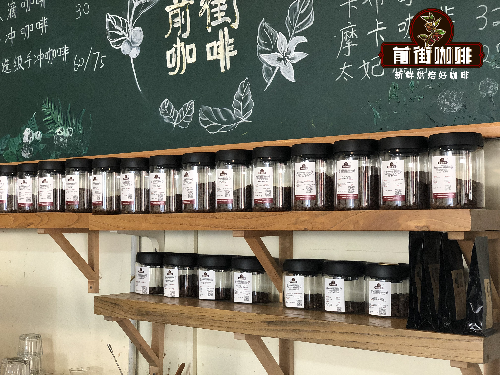
Professional coffee knowledge exchange more coffee bean information please follow the coffee workshop (Wechat official account cafe_style)
We all know that coffee producing areas are mainly divided into three major coffee producing areas: America, Asia and Africa. The flavor of coffee in each large producing area is very different and has its own characteristics. Many guests often come to the Qianjie coffee shop to discuss the relevant coffee knowledge. Qianjie found that some coffee lovers are very interested in the special treatment of coffee beans. So Qianjie is going to talk to you about the treatment of coffee beans today.

Generally speaking, the flavor of coffee beans depends largely on the origin, that is, the elevation, topography and climate often mentioned in Qianjie. It also depends in part on the way it is handled. Qianjie, for example, takes the washed Yejasuefei and suntanned cherries in the Yegashafi producing area of Ethiopia as an example. The coffee beans treated with water are very clean and bright, but there is also one deficiency. It is that the taste will be a little thinner. If you use sun-treated coffee beans, their mellow thickness and aroma, including sweetness, are stronger than those treated with water. So when you taste the coffee beans washed in water, in addition to the light aroma of jasmine, there are typical African notes of lemon and citrus, while the sweetness of sun-red cherries is more obvious after cooling, and the acidity is more raspberry flavor.

According to Qianjie, the washing method is generally used in Central America, especially in areas with abundant water resources. The general washing process is as follows: first, the coffee fruit is screened in the sink or bucket, and the immature coffee beans or sundries are removed, because defective beans have a great impact on the flavor of brewed coffee beans. Then the peeling machine was used to remove the peel and pulp of the selected coffee beans, then the peeled coffee beans were stored in a fermentation tank to remove the residual pectin and mucous membrane, and finally the washed beans were dried. The moisture content of the treated raw coffee beans is about 11Mul 13%.
Therefore, Qianjie believes that the greatest advantage of washing method is to put all coffee beans into buckets for screening at the very beginning, and in the following process, unripe beans and defective beans will be removed early, so the quality of raw beans treated with water washing is relatively high. coffee beans also look better than ordinary sun-dried beans. Then any treatment method has both advantages and disadvantages, one of the major disadvantages of water washing treatment is the waste of water resources, and water washing treatment is more complicated than the general treatment procedures, in the process of fermentation, coffee beans are easy to attach to the fermented taste, resulting in excessive sour taste and become inferior beans. If it is allowed to be neglected in the fermentation tank, it may also cause changes in the microorganisms, resulting in a decline in the quality of raw beans. I learned from Qianjie that in order to take out a kilogram of raw coffee beans, 50 liters of water is needed for washing. This is an almost impossible task in some coffee-producing countries where water is scarce. Washing requires a lot of machinery to carry out various operations, and it is also a heavy burden for coffee farmers in some countries.

Countries like Africa, such as Ethiopia, are more commonly used in the sun. The sun drying method is to dry the coffee fruit by natural drying after harvesting, so that the bright red coffee beans will become black dried coffee fruit. After this treatment process, the moisture content of coffee beans will be greatly reduced to 11muri 12%. The way of tanning is very simple, as long as the harvested coffee beans are spread out in the open air and dried in the sun for a few days. In order to uniform the dryness of coffee beans, but also to avoid coffee bean fermentation, the need to turn from time to time in the process of exposure, sun treatment is somewhat similar to the Chinese method of drying rice.

Of course, tanning also has its advantages and disadvantages. The advantages of solarization are low cost, simple operation and no complex equipment, so almost all coffee producing countries used this procedure to deal with raw beans in the past. However, the biggest disadvantage of this treatment is that it is subject to climatic conditions, takes a long time, and is easy to be mixed with too many defective beans or impurities. According to Qianjie, the countries that maintain the sun treatment are Brazil, Ethiopia, Yemen, Bolivia and other countries, of which Hara region of Ethiopia and Mocha in Yemen are famous sun-cured coffee beans.
You may see that you already know the traditional sun treatment and washing treatment like the back of your hand, but the treatment of coffee beans is not as simple as you think. On the basis of the two treatments, the clever Ka Nong derived the semi-washing method and the half-sun method according to the conditions of the natural environment.
Half-sun treatment, like the sunburn method mentioned in Qianjie above, is to improve the old sunburn method, first soak the newly harvested coffee beans into a large tank for screening, remove the defective beans and impurities, and then use the machine to remove the pulp and exocarp, but still retain the part of the coffee endocarp. Finally, the coffee beans covered with endocarp are sent to the sun field for sun drying. During drying in the sun, coffee beans are still turned from time to time to ensure that raw coffee beans are evenly dehydrated and avoid excessive fermentation. Half-sun-treated coffee beans will be left with endocarp for a period of time before export to wait for the coffee flavor to be ripe, and the endocarp will be removed from the beans before export. This treatment is very popular in Brazil.
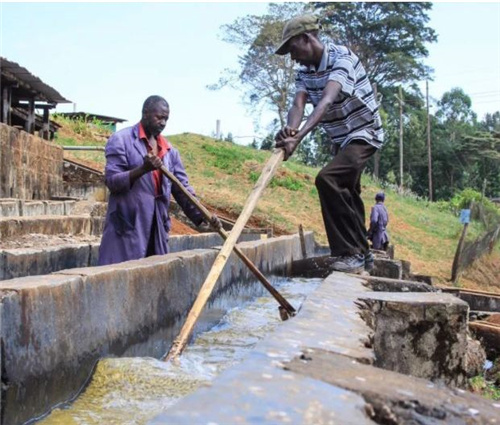
In the semi-washing process, the coffee fruit is first removed through the sink to remove the defective floating fruit, then the peel machine is used to remove the peel, pulp and part of the colloid layer, and then washed for an hour, because the immersion fermentation time is very short, the pectin is not easy to be washed away, and there is still pectin left on the bean shell. at this time, the treated coffee beans are spread in the exposure field to dry, and it is best to use an African viaduct with good permeability.
I do not know if you have noticed that the treatment method of semi-washing is very similar to the half-sun treatment mentioned in the front street. In fact, half-sun treatment and half-washing treatment actually express the same kind of treatment. Because these two treatments have corresponding sun and water washing processes, they are collectively called pulp solarization.
So countries that are short of water, such as Brazil, generally use half-sun to treat coffee beans. The use of half-sun treatment in Brazil also brings a distinctive coffee flavor to Brazilian coffee beans. Take the Brazilian Queen Manor on the front street bean list, for example, this coffee bean is half-sun.
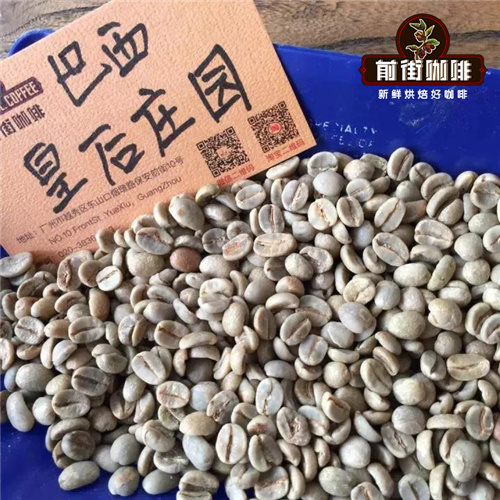
Qianjie takes into account the low moisture content of this coffee bean and the hard texture of the coffee bean, so it takes moderate roasting and the strong heat absorption of this bean, so it is necessary to have a good grasp of the baking time to highlight the aroma and mellow feeling of this half-sun-treated coffee bean. The common three-stage technique is used in the front street of cooking, the filter cup is Hario V60, the water temperature is 90 ℃, the amount of powder is 15 grams, the ratio of powder to water: 1:15, the degree of grinding: medium and fine grinding (BG#6S).
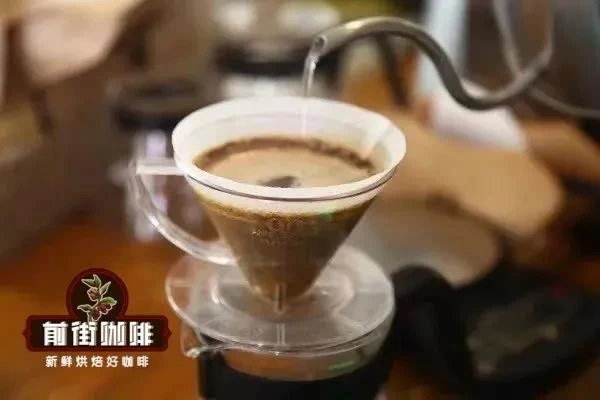
Qianjie generally use 30 grams of water for steaming for 30 seconds, small flow around the circle to 125 grams for sectional injection, water level drop is about to expose the powder bed to continue water injection to 225 grams to stop water injection, and other water level drop is about to expose the powder bed to remove the filter cup, (steaming starts timing) the extraction time is 2 kilograms 3910 00 ".
When tasting this coffee, you can clearly feel the sweetness of half-sun treatment, a hint of lemon, and the rich Brazil nut flavor of the Americas, with obvious dark chocolate flavor in the back, and the overall feeling is relatively round. it is a coffee bean that can represent the overall characteristics of Brazilian coffee, while reflecting its own unique liveliness.

For more boutique coffee beans, please add private Qianjie coffee on Wechat. WeChat account: kaixinguoguo0925
Important Notice :
前街咖啡 FrontStreet Coffee has moved to new addredd:
FrontStreet Coffee Address: 315,Donghua East Road,GuangZhou
Tel:020 38364473
- Prev
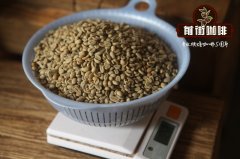
The difference between half-sun and half-washed coffee beans is the difference between half-sun and water-washed flavor and taste
Professional coffee knowledge exchange more information about coffee beans Please follow the coffee workshop (Wechat official account cafe_style) what's the difference between half-sun and half-washed coffee beans? What's the difference in flavor and taste between half-sun and water washing? Coffee beans are mainly treated in the sun and washing, as well as half-sun (or honey treatment) and semi-washing, both of which are more common.
- Next

What is the difference between solarization and half-solarization, washing and honey treatment? Characteristics of flavor and taste of sun-cured coffee beans?
Professional coffee knowledge exchange more coffee bean information please pay attention to the coffee workshop (Wechat official account cafe_style) half-sun and sun, washing, honey treatment of the difference? What are the flavor and taste characteristics of half-sun? What are the advantages and disadvantages of half-sun? 1. Solarization is the oldest treatment method, according to the literature.
Related
- Detailed explanation of Jadeite planting Land in Panamanian Jadeite Manor introduction to the grading system of Jadeite competitive bidding, Red bid, Green bid and Rose Summer
- Story of Coffee planting in Brenka region of Costa Rica Stonehenge Manor anaerobic heavy honey treatment of flavor mouth
- What's on the barrel of Blue Mountain Coffee beans?
- Can American coffee also pull flowers? How to use hot American style to pull out a good-looking pattern?
- Can you make a cold extract with coffee beans? What is the right proportion for cold-extracted coffee formula?
- Indonesian PWN Gold Mandrine Coffee Origin Features Flavor How to Chong? Mandolin coffee is American.
- A brief introduction to the flavor characteristics of Brazilian yellow bourbon coffee beans
- What is the effect of different water quality on the flavor of cold-extracted coffee? What kind of water is best for brewing coffee?
- Why do you think of Rose Summer whenever you mention Panamanian coffee?
- Introduction to the characteristics of authentic blue mountain coffee bean producing areas? What is the CIB Coffee Authority in Jamaica?

